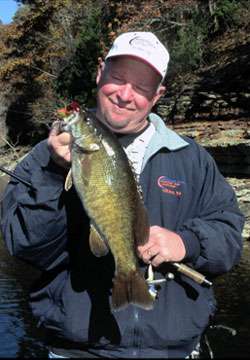
We live in an era of specialization. You can’t buy much of anything anymore that isn’t specially geared to a very particular purpose. It used to be that you went to the tackle store and looked at the fishing rods. Now you look at the bass rods or the muskie rods or the crappie rods.
Pretty soon, it’ll be the smallmouth rods or the largemouth rods. In fact, several manufacturers already do this with special series that are designed for particular members of the bass family.
I do the same thing. I think there are certain characteristics of rods and reels that make them better suited to brown bass than green bass.
If you read my rationale, you just might agree.
As for bass rods, I believe that a good smallmouth rod is generally a little longer than the same rod for largemouths. Why? There are a couple of reasons.
First of all, most of the smallmouth you catch will be a good deal deeper than the largemouths. That means you have more line out and have to move more line on your hook set. Nothing does that quite like a longer rod. Most of my smallmouth rods are between 6 feet, 9 inches and 7 feet, 3 inches.
Second, since smallmouth are usually out away from shoreline cover and since smallmouth waters are typically quite clear, it’s generally more important to make a long cast than it is to make a pinpoint-accurate cast. Thus, a long rod is better. You’ll be more accurate with a short rod, but you can’t cast as far.
Another quality I look for in my smallmouth rods is a super fast tip. I like that fast tip when smallmouth fishing because brown bass make harder, quicker surges than largemouths. A stiffer rod tip simply can’t handle it as well; you’ll break more lines and have more baits pull free with a stiffer rod tip.
I have my preferences for reels when smallmouth fishing, too. High speeds are nice, but far from critical. In fact, I think a fast reel can contribute to our fishing too fast if we’re not careful.
The thing I want from my smallmouth reels is a smooth drag. It’s absolutely essential with a casting reel. You’re drag is your lifeline when fishing with casting gear for smallmouth. It’s a little less critical when using spinning tackle for one very simple reason.
The reason a smooth drag isn’t so important to me when I’m fishing with spinning gear is that I never use the drag. Instead, I backreel.
Lots of fishermen — and especially largemouth fishermen — don’t even know what backreeling is today. If you’re one of them, don’t feel bad. I’m going to explain it right now.
You know that little switch on the body of your favorite spinning reel? It engages and disengages the drag, right? Well, I keep the drag off on my spinning reels almost all of the time.
That means that the handle will spin in either direction, picking up line one way and unspooling the reel if you go the other way. Backreeling is the practice of turning the reel handle backward to give the fish line rather than using the drag.
It’s not that I don’t trust the drag on my spinning reels — though generally I don’t — it’s that backreeling is better for two reasons.
For one, backreeling keeps you in complete control of the situation. When you’re using the drag, the fish is in control. If she’s big enough or strong enough, she’s going to take line through the drag system and you won’t be able to stop her very easily. But if you backreel, you’re in control and can decide exactly when to give her line and precisely when to take line in.
Of course, if you go the wrong way at the wrong time, you’ll end up with a broken line or a terrible tangle. So practice… a lot.
The other benefit of backreeling is that it helps you avoid one of the biggest hassles of fishing with spinning gear — line twist.
When line is pulled off the reel via the drag system, the line is twisted because it’s not coming off from the exact spot it went on. Instead, the spool is turning and the line is being pulled through the bail roller. This twists the line.
When you backreel, the line comes off in just the way it went on and without any twist. That’s what you want because line twist creates tangles and weakens your line — bad stuff when you’re hoping to hook the smallie of a lifetime.
Now backreeling is a pretty advanced technique today. Years ago, when spinning reel technology was a shadow of what it is now, everybody knew how to backreel. That’s not true anymore.
To get good at backreeling, you’re going to need to practice, and I’d recommend that you practice on small fish. No need to get your heart broken before you’ve mastered the technique.
It’s going to make you a better smallmouth angler.
Until next time, if you have any questions or comments, I’d love to hear from you. Please e-mail me at Stephen@thesmallmouthguru.com.





